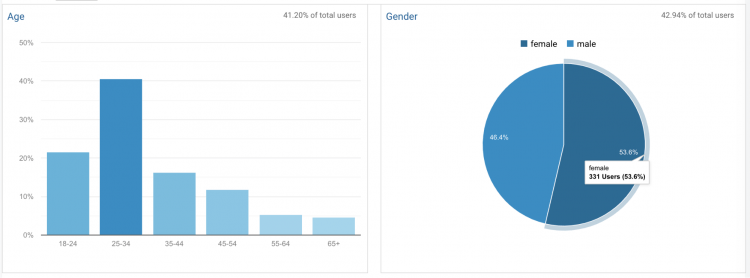How to Plan Your Nonprofit’s Year-End Media Buying

Request a Demo
Learn how top nonprofits use Classy to power their fundraising.
Media planning is the process of determining where to deliver your advertising message to best reach your desired audience. It is important because it helps you run effective and efficient marketing campaigns so you have the very best chance of achieving your marketing goals.
Planning out your media strategy helps ensure that you’ll be able to leverage your budget to get in front of the right audience with the right message at the right time. For example, if you want to target a younger audience to generate donations, but only have $2,000, planning out your campaign will decide how that the budget is best spent.
When it comes to the year-end fundraising season, media planning becomes even more crucial to the success of your nonprofit. You have to compete with countless other organizations and for-profit companies for the attention and money of the public.
Below, we outline a quick guide for how to approach nonprofit media buying in a way that helps your overall marketing efforts and drives fundraising revenue.
Get All Your Giving Tuesday and Year-End Resources
Considerations for Your Year-End Media Buying Plan
In order to build a successful year-end nonprofit media buying campaign, whether you’re running your first one or looking to improve an existing one, you’ll want to answer five simple questions:
- What is your objective?
- What is your budget and timeline?
- Who is your target audience(s)?
- What platforms should you use?
- What resources do you have available for creative?
To launch a successful campaign, you need a clearly defined goal. For your year-end campaign, you will most likely be focusing on driving donations. However, within this simple objective there are a few things to consider.
For instance, is your primary objective driving revenue or return on investment (ROI)? Is it important to you whether donors are new or returning, and if they give once or sign up for a monthly recurring donation?
Your objectives will help determine which platforms you select:
- ROI and Conversion: Social and paid search are great platforms for driving a return on investment.
- Awareness and Reach: Display and Video ads are great ads for driving awareness. You can drive low CPC, but not necessarily the greatest ROI.
Once you’ve answered these questions, it will be easier to determine which audiences, platforms, and budget strategy you need. Additionally, by identifying your goals early, you will be able to select the right platforms and build the right resources that allow you to set up and optimize your campaign appropriately.
For example, if you are looking to generate revenue, all the call to actions and ads should be set up and optimized for conversions. Your ads could say “Donate Now” or “Give today” driving individuals to a donation, optimizing all ads with this same donor journey.
If you are looking to drive high impressions, your campaign should be set up for impressions and reach. This means you just want to prioritize the most eyeballs possible on your ads over revenue generated from the ad.
Define Your Budget and Timeline
As you build your nonprofit media buying campaign, you’ll need to determine a concrete budget. This will ultimately help dictate how many audiences and which platforms you include in your campaign plan.
Many direct buy platforms have budget minimums starting at $10,000. If you know out of the gate you will have less than that, platforms like Facebook and Search that don’t have minimums, will be better suited for your budget.
With any campaign, you will want to make sure your budget is being spent wisely, especially if it is lean. Avoid overextending yourself on too many channels and instead focus on the ones that will deliver the best results. This may need just advertising on one platform and that’s OK.
When launching your campaigns, consider when it makes sense to add more budget or increase ad variations. For instance, you may want to allocate more budget on Giving Tuesday and save a significant chunk of the budget for the last week of December when people are making a lot of gifts at the end of the current tax year. This is a peak and valley approach where some key days will have a higher budget and other days will have a lower budget.
It’s also important to keep in mind the eCommerce calendar for retail and be conscious of days like Cyber Monday and Black Friday, which tend to be very expensive as retailers pump up their marketing efforts on Display and Social channels. You may wish to pull back during these times to avoid overpaying for clicks.
It’s vital that you have enough budget to optimize your campaign. After you launch your campaigns, we recommend a second round of quality assurance (QA) to make sure everything is serving and tracking properly.
Once your campaigns have accrued some data, you will want to check back regularly to make sure performance is in line with expectations and adjust as needed. Being nimble and flexible is an important skill for media planners. Even the most well-thought out campaigns are subject to change if you see under- or over-performance within a particular audience or channel.
Identify Your Target Audience(s)
A good rule of thumb for year-end giving is to start with your owned audiences: those who are familiar with your organization and may have even given in the past. These will be your most responsive prospects and cost-effective donors.
Here’s a few of “owned audiences” to consider:
- Website Visitors: People who have been cookied on your website.
- Email and Donor File: Folks on your email list who are prospects or current donors. By adding your CRM file into advertising platforms, you are able to match and target folks from your email list on various advertising platforms. Your donor file can be even more segmented for one-time , recurring, or lapsed donor.
- On-Platform Users: These are folks who have engaged with you on social media. People who have liked you posts or ads in the past.
- Branded Keywords: People who are searching for your brand on search. For example, anyone who is looking for your organization name.
With any of your “owned” audiences, keep in mind the larger fundraising strategy. These leads have a pre-existing relationship with your organization and will be exposed to messaging on other platforms.
It’s important to think about their entire donor journey so that it’s consistent. Make sure you coordinate your audiences and messaging across all channels including email. You don’t want a multi-year donor to receive an email to give a second gift or to ask a monthly giver to become a monthly giver if they already are.
If your budget allows, you may also wish to expand your audiences beyond owned media and incorporate qualified audiences such as lookalikes of your top donors or people with an interest in your organization’s mission, charitable giving, or related nonprofits. These are audiences you can create based on targeting parameters within your advertising platform.
- Lookalike Audience: This is an audience created based on another audience. For example, if you have your donor file on Facebook or have pixeled everyone who has landed on a donation thank you. You can create a list that mimics the criteria of those donor audiences.
- Like-minded: Maybe you have “like-minded” organizations with a large online presence. This could be another qualified audience to test. Individuals who engage with or follow your competitors.
- Nonprofit Givers: Maybe you want to hone in on individuals who have a previous giving history to other nonprofits, that could be another potential audience.
Not every platform has the same targeting capabilities, so you’ll need to pick and choose. Facebook has some of the most comprehensive options.
For example, if you’re an environmental organization, on Facebook you can create an audience that includes only individuals who care about the “environment” and have given to nonprofits before.
Free Download: Classy + Facebook—A Guide to Boosting Fundraiser Retention
Remember, prospective leads will tend to be “cold” or “lukewarm” meaning they may not know your organization personally, but care about the cause or maybe even support a like minded organization.
If your budget or on platform data is limited tools like Google Analytics are a great resource to familiarize yourself with your donor audience. You can analyze your past donors to understand who they are. For example, if the majority of your past donors were male ages 25 to 34, you can focus your budget on this demographic.

Select Your Advertising Platforms
Once you’ve done some research and analysis and have a general understanding of who you will be targeting, it’s time to select which platforms you will be using.
When selecting platforms you really need to consider the questions listed above:
- What is your objective? The objective will help determine what type of ads you will want to run which influences which platforms you use.
- Who is your target audience(s)? Of course your audience is a huge factor of where you place your ads. You’ll want to select platforms where your audience tends to engage.
- What is your budget and timeline? Your budget will determine how many platforms you can be on and which platforms to use. Some of the larger media partners have minimum advertising budgets starting at $10,000+.
- What resources do you have available for creative? If you have access to several creative resources where you can design various ads specs and maybe even video, this also will influence where you want to advertise.
Let’s dive a little deeper into your target audience and budget. If your donors tend to be older, Facebook is a great option, whereas if you have a younger donor set, Instagram could be a better fit.
Search is a platform that could potentially reach various audiences since it’s solely on their search terms. Understanding the demographics of each platform will take a bit of research.
If you have a small budget, using social media platforms and search is a great place to start. These platforms do not require any type of minimum spend—and are great at driving an ROI on direct response fundraising campaigns.
For larger budgets, you can expand into display and programmatic partners. Display campaigns on platforms like Google don’t have a budget minimum but don’t always have the same ROI as social media or search. If you use a programmatic advertising platform like Sharethrough, you’ll have an advertising minimum.
In any scenario, what you want to avoid is spreading your budget too thin and not giving the channels enough data to use for making optimizations.
Scope Out Your Resources and Creative Assets
The key to a successful campaign is developing creative that speaks to your audience and helps you stand out. We recommend creative that is eye-catching with high-quality visuals, a strong value proposition and a definitive call to action. For fundraising, telling a story and including concrete donation amounts are often successful tactics.
When creating ads it’s important to consider the specs of the ad platforms you are advertising. Adversely, it’s also important to consider the creative resources available when selecting the right platforms.
For example, if you have access to incredible videos, you should consider running ads on video heavy platforms. If you don’t have access to significant creative resources, maybe limit yourself to less platforms and only advertise on Facebook and search.
- Facebook and Instagram: Assets with little to no text on the image tend to perform better. However, Facebook did just announce the 20% rule has now been removed (as of September 2020). You could experiment some heavy text variations to see how they perform.
- Display: These ads can have a bit more text, but need to be incredibly clear as they can appear small and disappear quickly. It’s vital to design various ad sizes so that your ads are optimized on both mobile and desktop.


If possible, we recommend doing some pre-holiday testing to determine which types of messaging and formats resonate best with your audience. You don’t want to introduce brand new creative or messaging during year-end.
If it’s your first time advertising, start with two concepts and test those. Use email and social media to help you determine which messaging may work well for you.
Free Download: 28 Giving Tuesday Social Media Templates
Make sure your campaign is trackable
Make sure to have a plan in place for tracking revenue and ROI throughout the length of the campaign. Setting objectives won’t take you very far unless you have a good way to measure success.
The easiest way to set up Facebook conversion tracking is to follow these steps to have Classy’s support team add your organization’s Facebook Pixel. Make sure to request it be added account-wide in order to capture all data moving forward.
If you are using Google Ads to run media, you should also make sure to set up Google Ads Conversion Tags on your Classy account. You can complete a basic setup by following this process with Classy’s support team.
For a more advanced setup with value-based tracking, separate Conversion Tags for one-time and monthly donations, and additional tracking, we recommend taking advantage of Classy’s Google Tag Manager integration. As an official Classy integration partner, Media Cause has a number of packages available to get you set up with this powerful tracking solution.
Prior to launching your campaign, you should also make sure your organization’s Google Analytics account is set up to track donations from Classy under Conversions > Ecommerce. Simply enable Classy’s Google Analytics integration within the “Apps & Extensions” section of your Classy Manager dashboard and “Enable Ecommerce” is switched on in Google Analytics by navigating from Admin > Ecommerce Settings.
Other revenue monitoring tools include: adding UTM parameters and Source Codes to your URLs which feed into Google Analytics and fundraising platforms like Classy.
It is very important that you test to ensure tracking is working properly before your campaign launches to avoid losing important data.
Reporting on Results
We recommend pulling reporting regularly to help you track performance and make optimizations. It’s also important to look at ROI at a granular level, if possible, to help make key optimization decisions.
There are a number of tools that help make reporting easier such as Google Data Studio, which accepts data from Google Analytics, Google Ads, and other sources. Even a simple Excel spreadsheet containing key KPIs broken down at a platform, ad, and audience level can get the job done. You should also take advantage of Classy’s pre-built on-platform reports: look under the “General Reports” second of your dashboard for account-level reports and within individual campaigns under the “Reports” tab. For more advanced reporting on donor journeys and multiple touchpoints, explore Facebook Attribution and Google Attribution.
Crush Your Nonprofit Media Buying
Having a system for reporting on results will not only be super helpful in helping you optimize this campaign, but will be useful for pulling valuable insights to inform future initiatives.
Get Even More Giving Tuesday and Year-End Resources
Stephanie Schug is an Associate Media Director at Media Cause. Before joining the Media Cause team, Stephanie worked at Digitas LBi and 3Q Digital. She loves books, cats, and drinking too much coffee.

The Nonprofit Digital Marketing Checklist
Subscribe to the Classy Blog
Get the latest fundraising tips, trends, and ideas in your inbox.
Thank you for subscribing
You signed up for emails from Classy
Request a Demo
Learn how top nonprofits use Classy to power their fundraising.
 Explore Classy.org
Explore Classy.org 

